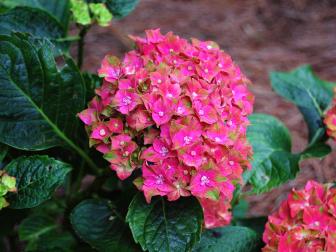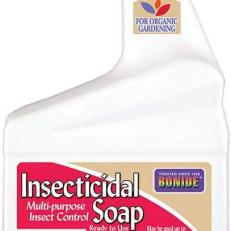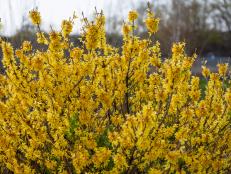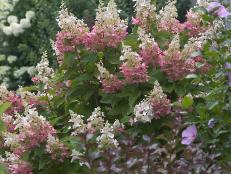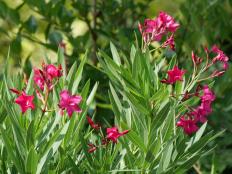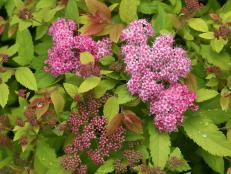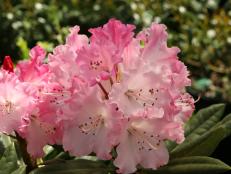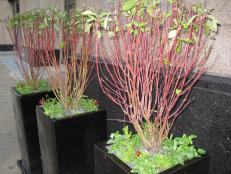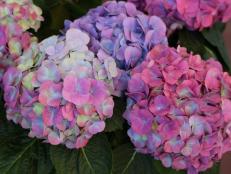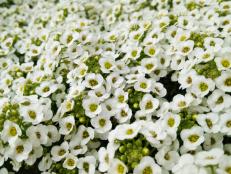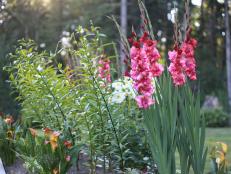How to Grow Oakleaf Hydrangea
With their big flowers, brilliant fall foliage and shaggy winter bark, oakleaf hydrangeas are year-round showstoppers for gardens and containers.

BaileyNurseries.com
Oakleaf hydrangea 'Jetstream' bears white flowers that slowly fade to shades of pink and linger into the winter. Hardy in Zones 5 to 8, it grows to 6 feet tall and 4 feet wide.

For year-round interest, plant oakleaf hydrangeas (Hydrangea quercifolia). These easy-to-grow, deciduous shrubs are native to the Southeastern U.S. and most are hardy in Zones 5-9.
Named for their leaves, which are lobed like oak tree leaves, they open cone-shaped panicles of white flowers from late spring into summer. As they age, the flowers turn pink to mauve or tan. Oakleaf hydrangea leaves start out green and change to spectacular shades of red, purple and rust in autumn. In winter, these tough, reliable plants add interest to the garden with their peeling, reddish-brown bark.
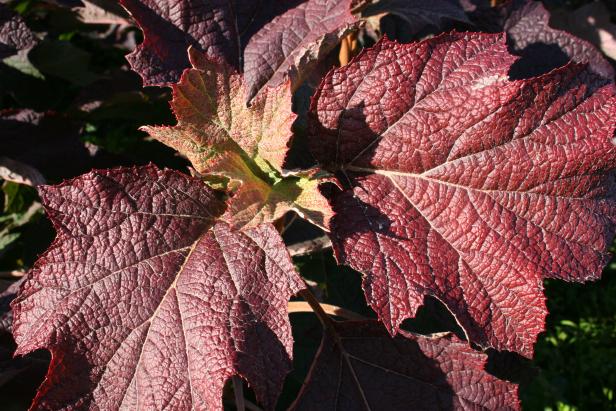
Bailey Nurseries
The brilliant fall colors of oakleaf hydrangeas contrast beautifully with evergreen shrubs and trees.
How to Grow Oakleaf Hydrangeas
Plant oakleaf hydrangeas in the spring or fall, when the cool temperatures allow them to develop a good root system and withstand the stress of transplanting.
Light
In the wild, oakleaf hydrangeas are understory plants, so use them in a woodland setting or dappled shade. A site with half a day of morning sun and afternoon shade is ideal, especially if you live in a hot climate. Too much sun will burn oakleaf hydrangea leaves, but too much shade results in fewer blooms and less colorful fall foliage. These shrubs bloom only once a year, but their flowers last a long time.
Soil
Oakleaf hydrangeas like organically rich, well-draining, slightly acidic soil with a pH of 5.0 to 6.5. Use a good quality potting mix for container plants.
Water
While oakleaf hydrangeas can tolerate drier conditions than most other types of hydrangeas, they like regular water and should stay evenly moist. Don’t let their soil get soggy.
Fertilize
These hydrangeas don’t usually need fertilizer. If they're in alkaline soil, you can feed them once a year in early spring with an acidic, granular fertilizer. Follow the product directions.
How to Plant Oakleaf Hydrangeas
Find a site that's the right size for the variety you want to grow. Most oakleaf hydrangeas grow 4 to 8 feet tall and wide and have a rounded growth habit. Dwarf types that reach 3 to 4 feet in size are good for containers and small gardens.
- Dig a hole slightly deeper and two to three times wider than the plant's root ball.
- Loosen its roots and put it in the hole, keeping the top of the root ball just above the soil line.
- Backfill the hole and gently firm down the soil.
- Water deeply and mulch with two or three inches of shredded bark, pine straw, compost or other organic matter.
Caring for Oakleaf Hydrangeas
These native shrubs can die to the ground and their flower buds can freeze in very cold weather. If you live in Zones 5 or 6, your plants may need some winter protection. After the ground freezes, mulch them 8 to 10 inches deep. Remove the mulch in early spring so the ground can warm up. Wrap young plants in burlap for the winter.
54 Gorgeous Hydrangea Varieties 59 Photos
This beautiful flowering shrub can add color and abundance to your garden.
How to Prune Oakleaf Hydrangeas
Oakleaf hydrangeas rarely need pruning, but you can lightly shape them or reduce them in size. Prune immediately after flowering. Buds form on old wood in late summer. If you wait too long to prune, you won’t get any flowers the following year.
Pests and Diseases
Although we've listed possible pests and diseases here, oakleaf hydrangeas are usually low-maintenance, nearly carefree plants.
Deer love to eat hydrangeas. Protect your plants with a deer repellant or put a fence or other physical barrier around them.
Other than aphids and spider mites, few insect pests attack oakleaf hydrangeas. Use a blast of water from your hose to knock them off and repeat as needed. If they persist, spray aphids with an insecticidal soap labeled for this use or use a miticide for mites. Always follow your product's directions. To discourage pests from attacking in the first place, keep the plants healthy by watering regularly, especially in dry weather.
Root rot causes wilting that doesn’t recover after watering. There’s no chemical control for this fungal disease. To help prevent it, keep your plants watered and fertilized if fertilizing is indicated by a soil test. Don’t plant oakleaf hydrangeas where the ground stays soggy.
Cool, wet weather can encourage botrytis blight, which looks like small, wet spots on leaves that spread into big, brown patches. To help prevent it, avoid getting the foliage wet when you water and make sure your plants have good air circulation.
Leaf spot causes brown or purplish spots on oakleaf hydrangeas. Leaves can turn yellow and drop if they’re severely affected. Avoid watering from overhead, give the plants good air circulation and spray with a copper-based fungicide, following the label directions, if needed.
Powdery mildew looks like a white, fuzzy growth and can cause yellow or purple leaf spots. Clean up and discard fallen leaves. Chemical controls aren’t usually necessary, although you can use horticultural oil or another product labeled for this problem.
If Japanese beetles show up, knock them into a bucket of soapy water. Avoid using insecticides, since they can also kill beneficial insects.
How to Propagate Oakleaf Hydrangeas
Growing oakleaf hydrangeas from seeds is tricky because the tiny seeds are hard to collect and handle. It’s easier to propagate the plants from stem cuttings.
- In early summer, use clean, sterile pruners to make a few 5- to 6-inch cuttings from green, flowerless stems. Make sure they have at least one node (a knobby line where new growth emerges).
- Cut off the top half of any large leaves on the cuttings. (Since the cuttings lack roots, they can’t support big leaves.) If the leaves are small, remove all but two or three leaves at the top of the cutting.
- Dip the ends of the cuttings in rooting hormone and plant them in pots filled with moist seed-starting soil.
- Cover the pots with plastic bags, keep them out of direct sun and ensure the soil stays moist.
- When roots form, in about 12 weeks, remove the bags and transplant the cuttings.
Propagating by ground layering is also easy.
- Start with a branch of the main plant that’s hanging close to the ground.
- Scrape off a little bark on the underside.
- Bend the branch over and bury at least one leaf node in the ground.
- Use a brick to hold the branch in place.
- When roots form, cut off the branch and transplant it as desired.
Varieties, Species and Cultivars of Oakleaf Hydrangeas
Most of these hydrangeas are hardy in Zones 5 to 9, except as noted.
'Jetstream' is a tough beauty with showy white blooms and strong stems that resist flopping over. While the flowers age to light pink, the dark green leaves turn red-orange in fall. 'Jetstream' resists leaf spot. It's hardy to Zone 8.
'Ruby Slippers' bears large, white, upright blooms that quickly change to deep pink. Its fall foliage is bright mahogany. This dwarf oakleaf hydrangea grows 3 1/2 feet tall to 4 to 5 feet wide. Use it in hedges, borders, a woodland garden or as a specimen plant.
'Gatsby Gal' has white panicle flowers that turn pink to wine-red in autumn. Give it winter protection in zones 5 and 6.
'Gatsby Star' is a showstopper, thanks to doubled flowers with star-shaped petals. The panicles turn pink in fall while the green leaves become burgundy. Grow it in the landscape or as a “thriller” in a large container.
'Gatsby Moon' is another showy entry in the ‘Gatsby’ series with densely packed, doubled flowers. The full panicles have an unusual “quilted” look and change from white to green with age.
'Snow Queen' has dark green foliage with dense flower clusters that measure 6 to 8 inches long. They mature to rose-pink in the fall, while the leaves turn a dark, reddish-bronze. Try this large, impressive plant as a landscape specimen, flowering hedge or around a foundation.
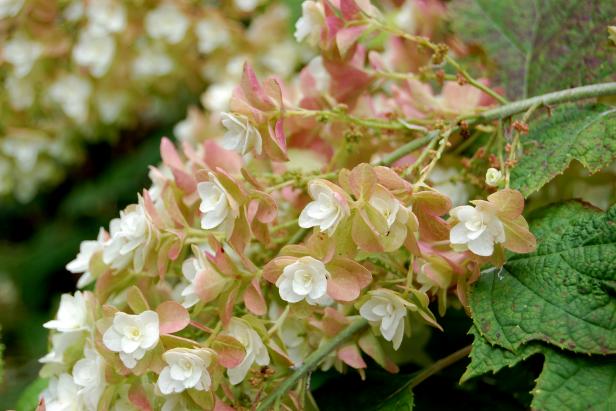
Image courtesy of Julie Taylor Fitzgerald, American Hydrangea Society
'Snowflake' has white flower panicles that age to pink.
'Munchkin' bears white flower clusters that stay upright even after heavy rainfall. At 3 to 4 1/2 feet tall and wide, it’s compact enough to grow in groups or as a hedge. In autumn, its mahogany leaves stand out beautifully against the greenery of azaleas, hollies and hostas.
'Snow Flake' has clusters of white blooms with petals that look like big snowflakes. Its flowers open throughout the summer for a longer-than-usual blooming season. In fall, the leaves turn crimson and brilliant purple. This fast-growing oakleaf hydrangea reaches 4 to 6 feet tall and wide.
'Pee Wee', as its name implies, is a dwarf oakleaf hydrangea that’s great for a small garden or as a foundation or border shrub. Its springtime flowers are white and age to pink. By winter, its bark is the color of cinnamon. It grows moderately fast to 4 feet tall and 3 feet wide.
'Alice' is one of the largest, most impressive oakleaf hydrangeas, growing 12 to 15 feet tall and wide. Plant it around foundations or in a cutting garden or border. The fall foliage is a fiery crimson, and the summer flowers are creamy-white. It has a rather rangy growth habit that also works well in a woodland setting.






